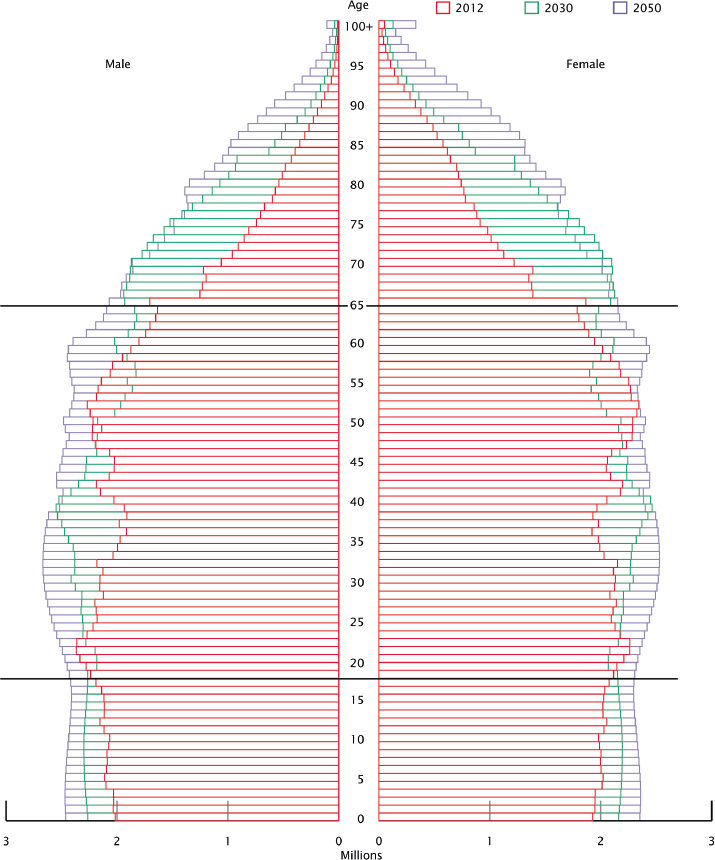2 Geriatric Otolaryngology: An Overview
 Changing Demographics
Changing Demographics
Since the beginning of recorded human history, young children have outnumbered older people. In a shifting global trend, people over the age of 65 will soon outnumber children under the age of 5. As a result of declining birth rates and increasing life spans, the geriatric age group is the fastest-growing segment of our society.1 In 2006, almost 500 million people worldwide were 65 and older, accounting for 8% of the world’s population. By 2030, that total is projected to increase to 1 billion or more, amounting to one out of every eight, or 12.5% of the Earth’s inhabitants. Of note, the most rapid increases in the 65 and older population are occurring in developing countries, which will witness a jump of 140% by the year 2030. In the United States alone, fully 20% of the population will be 65 or older by the year 2030. The median age of North Americans has seen a rise from 30 in 1960, to 34 in 1994, and is estimated to reach 41 by 2030.1 An important, and sometimes overlooked, feature of population aging is the progressive aging of the older population itself.2,3
Over time, more older people are surviving to even more advanced ages. The “oldest old” are often defined as people age 85 and over. Because of chronic disease, the oldest old have the highest population levels of disability that require long-term care. Consequently, they also consume public resources disproportionately when compared with those in younger age groups. The health, economic, and social needs of this group differ significantly from those of patients aged 65 to 84. The oldest old currently account for 7% of the world’s population aged 65 and over: this number rises to 10% in more developed countries and falls to 5% in less developed countries. In the United States, as the number of oldest old increases, it is estimated that they will account for 14% of the population by 2040. People of extreme old age, defined as 100 years of age or more, are referred to as centenarians. Although they currently constitute a small portion of the total population in most countries, their numbers are growing quite dramatically, having doubled each decade since 1950 in more developed countries.2,3 These changes affect the traditional representation of populations as a pyramid. As the number of older people increases, and the number of younger people decreases, the pyramid takes on a square configuration, possibly eventually becoming inverted if current trends continue (Fig. 2.1).4
Global aging is a success story with people living longer and generally healthier lives, particularly in developed countries. Increased life expectancy reflects several health transitions occurring around the globe at different rates. Changes affecting life expectancy include the following:
• Shift from high to low fertility
• Increase in life expectancy at birth and at older ages
• Shift from infectious and parasitic diseases to noncommunicable diseases and chronic conditions
• Economic development
• Ongoing medical advances
• New drugs
Sustained growth of the world’s older population, however, also creates important challenges.5 Population aging affects economic growth, formal and informal social support systems, and the ability of states and communities to provide resources for older citizens. The “old-age dependency ratio” reflects the proportion of young individuals available to support the old in our society.1 Currently, there are ~ 5 individuals supporting every elderly person, with a ratio of ~ 20. By 2050, it is estimated that there will only be 2.5 supporting individuals for every elderly person, with a ratio of ~ 40. Despite some recognized shortcomings of this ratio, it is nonetheless useful as a crude indicator of the level of economic and physical dependency of the geriatric population. Furthermore, the elderly consume a disproportionate amount of the total health care resources available. Attempting policy adjustments such as changes in retirement ages and medical benefits may be painful and unpopular. Nonetheless, it is incumbent upon nations to quickly recognize the scope of the new demographic reality and adjust current and future policies accordingly.2,3
Fig. 2.1 Age and sex structure of the population for the United States for the years 2010, 2030, and 2050. (Courtesy of U.S. Census Bureau, 2012 Population Estimates and 2012 National Projections.)
 General Concepts in Geriatrics
General Concepts in Geriatrics
The Canon of Medicine, written by Avicenna in 1025, was the first book to offer instruction in the care of the elderly, foreshadowing modern gerontology and geriatrics. In a chapter entitled “Regimen of Old Age,” Avicenna expressed concern with his observation that “old folk need plenty of sleep”; he suggested that their bodies should be anointed with oil and even recommended exercises such as walking or horseback riding. Thesis III of the Canon discussed a diet felt to be suitable for the elderly and dedicated several sections to the problem of constipation in geriatric patients. George Day published the A Practical Treatise on the Domestic Management and Most Important Diseases of Advanced Life in 1851, one of the first publications on the subject of geriatric medicine. The first modern geriatric hospital was founded in Belgrade, Serbia, in 1881 by doctor Laza Lazarević. In 1909, the term geriatrics
Stay updated, free articles. Join our Telegram channel

Full access? Get Clinical Tree



